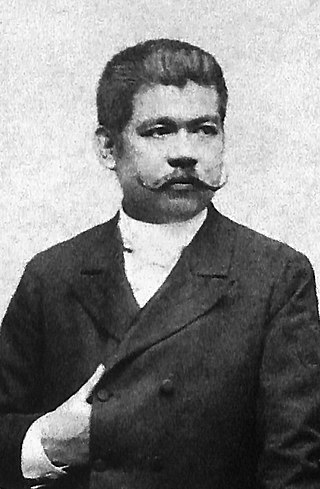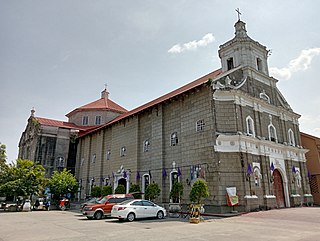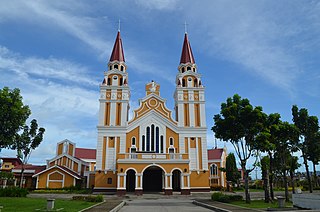
Porac, officially the Municipality of Porac, is a 1st class municipality in the province of Pampanga, Philippines. According to the 2020 census, it has a population of 140,751 people.

Abra, officially the Province of Abra, is a 3rd class province in the Cordillera Administrative Region of the Philippines. Its capital is the municipality of Bangued. It is bordered by Ilocos Norte on the northwest, Apayao on the northeast, Kalinga on the mid-east, Mountain Province on the southeast, and Ilocos Sur on the southwest.

Fernando Manuel de Bustillo Bustamante y Rueda served as the 37th Governor-General of the Captaincy General of the Philippines from 1717 until his assassination.

The Cavite mutiny was an uprising of Filipino military personnel of Fort San Felipe, the Spanish arsenal in Cavite, Philippine Islands on January 20, 1872. Around 200 locally recruited colonial troops and laborers rose up in the belief that it would elevate to a national uprising. The mutiny was unsuccessful, and government soldiers executed many of the participants and began to crack down on a burgeoning Philippines nationalist movement. Many scholars believed that the Cavite mutiny was the beginning of Filipino nationalism that would eventually lead to the Philippine Revolution of 1896.

The Real Fuerte de Nuestra Señora del Pilar de Zaragoza, also Fort Pilar, is a 17th-century military defense fortress built by the Spanish colonial government in Zamboanga City. The fort, which is now a regional museum of the National Museum of the Philippines, is a major landmark of the city and it symbolize the cultural heritage.

The Minor Basilica of Saint Michael the Archangel (Tagalog: Basílika Menor ni San Miguel Arkanghel; Spanish: Basílica Menor de San Miguel Arcángel) commonly known as the Tayabas Basilica, is a Roman Catholic basilica located in Tayabas, Quezon, Philippines under the Diocese of Lucena. Its titular is Saint Michael the Archangel, whose feast is celebrated every September 29.
The Congregation of the Dominican Sisters of St. Catherine of Siena is a Dominican congregation of religious sisters under the patronage of St. Catherine of Siena. It was founded by Father Juan de Sto. Domingo, OP and Mother Francisca del Espiritu Santo de Fuentes in 1696 for Spanish women only.

Marcelo Hilario del Pilar y Gatmaitán, commonly known as Marcelo H. del Pilar and also known by his pen name Pláridel, was a Filipino writer, lawyer, journalist, and freemason. Del Pilar, along with José Rizal and Graciano López Jaena, became known as the leaders of the Reform Movement in Spain.

Francisco de la Cuesta, O.S.H. was the 12th Archbishop of Manila from 1707 to 1722, and Spanish Governor-General of the Philippines from 1719 to 1721.

Tata Vasco is an opera in five scenes composed by Miguel Bernal Jiménez to a Spanish libretto with nationalistic and devoutly Roman Catholic themes by the Mexican priest and poet, Manuel Muñoz. It premiered in Pátzcuaro, Mexico on 15 February 1941. The opera is based on the life of Vasco de Quiroga, the first Bishop of Michoacán and known to the indigenous Purépecha of the region as 'Tata Vasco'. Considered one of Bernal Jiménez's most emblematic scores, the music incorporates native melodies, dances, and instruments as well as elements of Gregorian chant.

La Dolores is a Spanish opera in 3 acts by Tomás Bretón. The libretto was arranged by composer himself from a same-name drama by Josep Feliu i Codina (1892). The opera was first performed at the Teatro de la Zarzuela in Madrid on 16 March 1895 and was an immediate success. The most famous piece from the opera is the grandiose jota from the finale of the first act.
Juan Manuel de la Peña Bonifaz was a Spanish politician who served as the ad interim 26th governor and captain-general of the Philippines from September 28, 1668 to September 24, 1669. Prior to his term being the governor-general, he served as the junior auditor of the Real Audiencia of Manila before he held the highest position by trickery. He succeeded Diego de Salcedo as the governor.
Estéban de Perea was a Spanish Franciscan friar who undertook missionary work in New Mexico, a province of New Spain, between 1610 and 1638. At times he was in conflict with the governors of the province. He has been called the "Father of the New Mexican Church".

Fray José de Guadalupe Mojica was a Mexican Franciscan friar and former tenor and film actor. He was known in the music and film fields as José Mojica.

Dolores Claiborne is an opera in two acts composed by Tobias Picker to a libretto by J. D. McClatchy. Based Stephen King's 1992 novel Dolores Claiborne, the opera was commissioned by the San Francisco Opera and premiered in San Francisco on September 18, 2013. In 2017, the New York City Opera performed the world premiere of a new chamber version of the opera at the 59E59 Theater A, directed by Michael Capasso. In 2019, it was produced by the Boston University Opera Institute.

The National Shrine of La Virgen Divina Pastora, known canonically as the Three Kings Parish, is a shrine in Gapan in the Philippines that was founded in 1589.

The Metropolitan Cathedral of Our Lord's Transfiguration, also known as Palo Metropolitan Cathedral or simply Palo Cathedral, is a Roman Catholic church located at Palo, Leyte, in the Philippines belonging to the Vicariate of Palo under the Metropolitan Archdiocese of Palo.
José Torralba Rios (1653-1726) was a Spanish oidor and licentiate who served as the 36th Governor-General of the Philippines. He is the eighth Governor-General of the Philippines from the Real Audiencia of Manila.
Fides Belza Cuyugan-Asensio is a Filipino coloratura soprano, actress, director, librettist, translator, and teacher.

Alegria Ocampo Ferrer is a Filipina soprano, professor, theater actress and a musical director who is awarded an Aliw Awards Hall of Fame in the category of Female Classical and included in the Cultural Center of the Philippines (CCP) Encyclopedia of the Arts. The Aliw Awards is given to recognize excellence in Filipino talents. The CCP Encyclopedia of the Arts contains information about culture and the arts in the Philippines.















